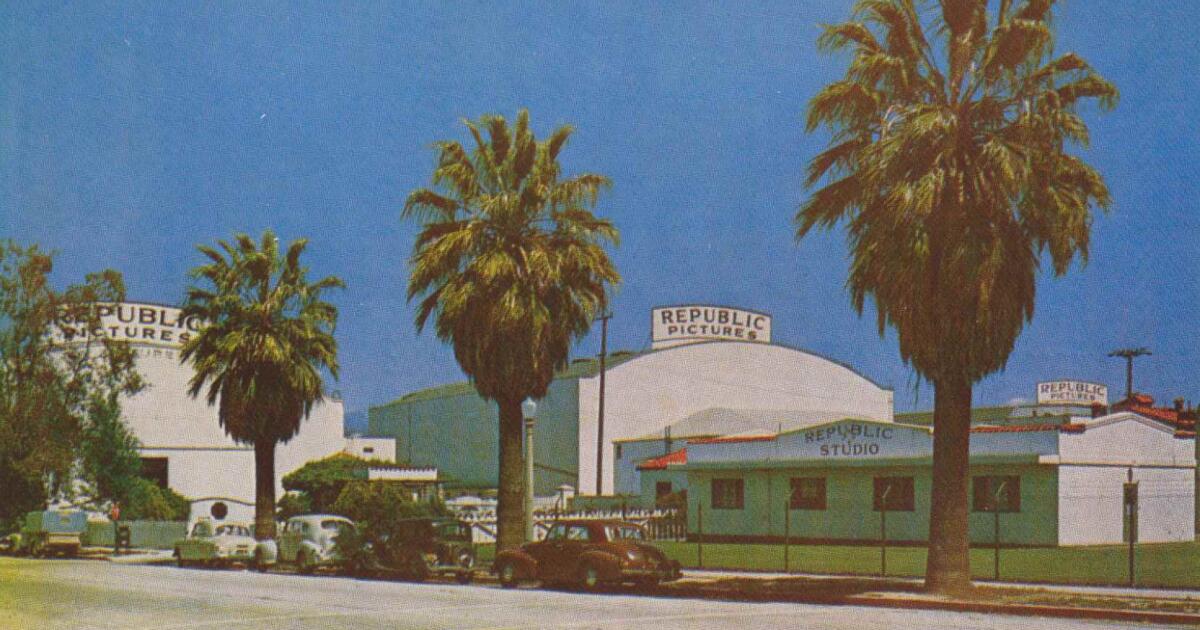Call forth the mourners from far and wide.
And remind them to bring their chainsaws.
We gather to prepare ourselves to bid a frond farewell to Los Angeles’ palm trees.
Don’t freak out. This isn’t an alert about any wholesale dying of palms. Not all of them, anyway, and not right away. But Ecclesiastes got it right about everything having a season, “a time to plant, and a time to pluck up that which is planted.”
The season — the long, long winning season — for so many of our palm trees is running its course. Our exotic, come-hither, haphazard forest is being slowly timed out.

Can we imagine Hollywood without palm trees?
(Justin W Dennis / Justin – stock.adobe.com)
We stand at an inflection point for L.A., after the fires, in the grip of climate change, recalibrating our future right down to the roots. Literally to the roots. Uncounted thousands of trees burned in the fires. Thousands more are getting thinned out by disease and drought and age. How do we replace our geriatric urban forest with more and better trees?
Original L.A. was not the forest primeval. It was a landscape of scrubby shrubs and chaparral and grasses. What native trees there were grew alongside water, which flowed abundantly, if seasonally, until we took over the land and dried up the waterways.
Palm trees came to town with the missionaries, for religious ceremonies, and then, decades later, with the great PR sales pitch of Southern California being the “American Mediterranean,” which demanded the right set dressing — palm trees.
The City Beautiful movement of the 1910s and1920s and the glories of the 1932 Olympics stuck thousands of trees of all kinds into the ground to adorn public L.A. All they had to do was look good; to fret over drought or heat was treason.
Angelenos’ faith that pretty much anything could grow here was usually right. The unlikeliest tree cuttings from the world over were carried here, adapted and came to elbow out the locals.
Thus, Los Angeles became a tree zoo.
Now it’s time to make it a tree ark, and not every species should make it aboard.
Climate change changes cities. We can no longer afford freeloader trees, however glamorous. Palms suck down water like camels, but give back barely enough leafiness to shade a Hula-Hoop. Falling fronds can deliver a mean whack, and during fires, palms light up like a flare.

People use a garden hose to extinguish a palm tree fire on Jan. 8.
(Jason Armond / Los Angeles Times)
The nonprofit TreePeople has been trying to prep us for this for years.
Bryan Vejar is a master arborist who directs community forestry for TreePeople, and, yes, in fact, he does have a few thoughts on the topic, and this is the moment we need to hear them, so take it away, Mr. Vejar:
“Trees are not some cosmetic thing, some ornament. They’re also critical infrastructure, like traffic signs and traffic lights. They have tremendous value for the health and safety of the community.”
“We should be planting trees that serve a greater range of ecological benefits. There’s not just one clear answer. The trees we plant now have to be climate-adaptive for weather forecasts for 50 and 60 years.”
“Native trees also support local wildlife, specifically ones endemic to our geographical biome. Pollinators, nesting birds, migratory birds and other species rely on them.”
“Not a lot of trees check every box. You want trees that are very durable and very resilient, that can endure many different soil types in any given community.”
All right, then. What’s in, and what’s out once we cart away old trees and/or plant new ones?
Out: most palms. And don’t replace them with something like crape myrtle, which is pretty but doesn’t offer much shade for the space it takes up.
Most eucalyptus, out. They’re invasive below ground and tiki torches above.
Sweet gums, out; They’re also invasive, triggering allergies, and dropping nasty, spiky balls like alien spoor. (Some trees appear on a city-approved list, but TreePeople gives them a “branches-down.”)

Jacarandas in bloom in Long Beach in May 2024.
(Christina House / Los Angeles Times)
I share Vejar’s loathing for the relentless “tree of heaven,” the deciduous plant that is sometimes called a stinking sumac. You see it everywhere; it not only crowds out natives, it also poisons the soil to kill off the competition and ruins biodiversity. Its leaves can also kill your dog. If you see one in your garden, kill it before it kills us.
Vejar’s “ins” include native oaks and some sycamores, black walnut trees, desert willows, drought-tolerant African sumac and Chinese pistache.
Ficus trees scrub away air pollution and cast vast shade, something vital when an urban forest can lower temperatures by 10 or 20 degrees. Ideal, right? Yet cities planted them unwisely alongside sidewalks, which their mature roots now crack and split.
“The thing that makes it a workhorse for urban forests,” says Vejar, “is also what makes cities have to pay out millions in lawsuits from people tripping, ADA violations and such.”
So, suppose the palms do take their last bow? Which understudy is ready to step onstage as our new arboreal star? Oaks and sycamores are too generic. Orange trees? Memento mori.
But the jacaranda — now there’s beauty. Fast-growing, generous with shade, drought-tolerant and soil-forgiving. Bees and butterflies love them. And did I mention beautiful? That ultraviolet haze shimmering around a blossoming jacaranda delivers a moment of transcendent enchantment.
So what if the fallen petals are sticky? It’s a small toll paid to glory. Like a wad of gum dropped on the Hollywood Walk of Fame.
This story originally appeared on LA Times

